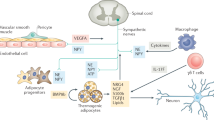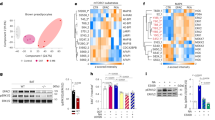Abstract
Maintenance of body temperature is essential for the survival of homeotherms. Brown adipose tissue (BAT) is a specialized fat tissue that is dedicated to thermoregulation1. Owing to its remarkable capacity to dissipate stored energy and its demonstrated presence in adult humans2,3,4,5, BAT holds great promise for the treatment of obesity and metabolic syndrome1. Rodent data suggest the existence of two types of brown fat cells: constitutive BAT (cBAT), which is of embryonic origin and anatomically located in the interscapular region of mice; and recruitable BAT (rBAT), which resides within white adipose tissue (WAT)6 and skeletal muscle7, and has alternatively been called beige8, brite9 or inducible BAT10. Bone morphogenetic proteins (BMPs) regulate the formation and thermogenic activity of BAT10,11,12. Here we use mouse models to provide evidence for a systemically active regulatory mechanism that controls whole-body BAT activity for thermoregulation and energy homeostasis. Genetic ablation of the type 1A BMP receptor (Bmpr1a) in brown adipogenic progenitor cells leads to a severe paucity of cBAT. This in turn increases sympathetic input to WAT, thereby promoting the formation of rBAT within white fat depots. This previously unknown compensatory mechanism, aimed at restoring total brown-fat-mediated thermogenic capacity in the body, is sufficient to maintain normal temperature homeostasis and resistance to diet-induced obesity. These data suggest an important physiological cross-talk between constitutive and recruitable brown fat cells. This sophisticated regulatory mechanism of body temperature may participate in the control of energy balance and metabolic disease.
This is a preview of subscription content, access via your institution
Access options
Subscribe to this journal
Receive 51 print issues and online access
We are sorry, but there is no personal subscription option available for your country.
Buy this article
- Purchase on SpringerLink
- Instant access to full article PDF
Prices may be subject to local taxes which are calculated during checkout




Similar content being viewed by others
References
Cannon, B. & Nedergaard, J. Metabolic consequences of the presence or absence of the thermogenic capacity of brown adipose tissue in mice (and probably in humans). Int. J. Obes. Lond. 34 (suppl. 1). S7–S16 (2010)
Cypess, A. M. et al. Identification and importance of brown adipose tissue in adult humans. N. Engl. J. Med. 360, 1509–1517 (2009)
Nedergaard, J., Bengtsson, T. & Cannon, B. Unexpected evidence for active brown adipose tissue in adult humans. Am. J. Physiol. Endocrinol. Metab. 293, E444–E452 (2007)
van Marken Lichtenbelt, W. D. et al. Cold-activated brown adipose tissue in healthy men. N. Engl. J. Med. 360, 1500–1508 (2009)
Virtanen, K. A. et al. Functional brown adipose tissue in healthy adults. N. Engl. J. Med. 360, 1518–1525 (2009)
Guerra, C., Koza, R. A., Yamashita, H., Walsh, K. & Kozak, L. P. Emergence of brown adipocytes in white fat in mice is under genetic control. Effects on body weight and adiposity. J. Clin. Invest. 102, 412–420 (1998)
Almind, K., Manieri, M., Sivitz, W. I., Cinti, S. & Kahn, C. R. Ectopic brown adipose tissue in muscle provides a mechanism for differences in risk of metabolic syndrome in mice. Proc. Natl Acad. Sci. USA 104, 2366–2371 (2007)
Wu, J. et al. Beige adipocytes are a distinct type of thermogenic fat cell in mouse and human. Cell 150, 366–376 (2012)
Petrovic, N. et al. Chronic peroxisome proliferator-activated receptor γ (PPARγ) activation of epididymally derived white adipocyte cultures reveals a population of thermogenically competent, UCP1-containing adipocytes molecularly distinct from classic brown adipocytes. J. Biol. Chem. 285, 7153–7164 (2010)
Schulz, T. J. et al. Identification of inducible brown adipocyte progenitors residing in skeletal muscle and white fat. Proc. Natl Acad. Sci. USA 108, 143–148 (2011)
Tseng, Y. H. et al. New role of bone morphogenetic protein 7 in brown adipogenesis and energy expenditure. Nature 454, 1000–1004 (2008)
Whittle, A. J. et al. BMP8B increases brown adipose tissue thermogenesis through both central and peripheral actions. Cell 149, 871–885 (2012)
Seale, P. et al. PRDM16 controls a brown fat/skeletal muscle switch. Nature 454, 961–967 (2008)
Timmons, J. A. et al. Myogenic gene expression signature establishes that brown and white adipocytes originate from distinct cell lineages. Proc. Natl Acad. Sci. USA 104, 4401–4406 (2007)
Atit, R. et al. β-catenin activation is necessary and sufficient to specify the dorsal dermal fate in the mouse. Dev. Biol. 296, 164–176 (2006)
Lepper, C. & Fan, C. M. Inducible lineage tracing of Pax7-descendant cells reveals embryonic origin of adult satellite cells. Genesis 48, 424–436 (2010)
Schmid, P., Lorenz, A., Hameister, H. & Montenarh, M. Expression of p53 during mouse embryogenesis. Development 113, 857–865 (1991)
Sanchez-Gurmaches, J. et al. PTEN loss in the Myf5 lineage redistributes body fat and reveals subsets of white adipocytes that arise from Myf5 precursors. Cell Metab. 16, 348–362 (2012)
Buckingham, M. E., Lyons, G. E., Ott, M. O. & Sassoon, D. A. Myogenesis in the mouse. Ciba Found. Symp. 165, 111–131 (1992)
Kishigami, S. & Mishina, Y. BMP signaling and early embryonic patterning. Cytokine Growth Factor Rev. 16, 265–278 (2005)
Gupta, R. K. et al. Transcriptional control of preadipocyte determination by Zfp423. Nature 464, 619–623 (2010)
Farmer, S. R. Transcriptional control of adipocyte formation. Cell Metab. 4, 263–273 (2006)
Cannon, B. & Nedergaard, J. Nonshivering thermogenesis and its adequate measurement in metabolic studies. J. Exp. Biol. 214, 242–253 (2011)
Fisher, F. M. et al. FGF21 regulates PGC-1α and browning of white adipose tissues in adaptive thermogenesis. Genes Dev. 26, 271–281 (2012)
Boström, P. et al. A PGC1-α-dependent myokine that drives brown-fat-like development of white fat and thermogenesis. Nature 481, 463–468 (2012)
Collins, S. β-Adrenoceptor signaling networks in adipocytes for recruiting stored fat and energy expenditure. Front. Endocrinol. 2, 102 (2011)
Tseng, Y. H., Cypess, A. M. & Kahn, C. R. Cellular bioenergetics as a _target for obesity therapy. Nature Rev. Drug Discov. 9, 465–482 (2010)
Feldmann, H. M., Golozoubova, V., Cannon, B. & Nedergaard, J. UCP1 ablation induces obesity and abolishes diet-induced thermogenesis in mice exempt from thermal stress by living at thermoneutrality. Cell Metab. 9, 203–209 (2009)
Rothwell, N. J. & Stock, M. J. Surgical removal of brown fat results in rapid and complete compensation by other depots. Am. J. Physiol. 257, R253–R258 (1989)
Xue, B. et al. Genetic variability affects the development of brown adipocytes in white fat but not in interscapular brown fat. J. Lipid Res. 48, 41–51 (2007)
Dudas, M., Sridurongrit, S., Nagy, A., Okazaki, K. & Kaartinen, V. Craniofacial defects in mice lacking BMP type I receptor Alk2 in neural crest cells. Mech. Dev. 121, 173–182 (2004)
Mishina, Y., Hanks, M. C., Miura, S., Tallquist, M. D. & Behringer, R. R. Generation of Bmpr/Alk3 conditional knockout mice. Genesis 32, 69–72 (2002)
Tallquist, M. D., Weismann, K. E., Hellstrom, M. & Soriano, P. Early myotome specification regulates PDGFA expression and axial skeleton development. Development 127, 5059–5070 (2000)
Abel, E. D. et al. Adipose-selective _targeting of the GLUT4 gene impairs insulin action in muscle and liver. Nature 409, 729–733 (2001)
Yi, S. E., Daluiski, A., Pederson, R., Rosen, V. & Lyons, K. M. The type I BMP receptor BMPRIB is required for chondrogenesis in the mouse limb. Development 127, 621–630 (2000)
Kaufman, M. H. The Atlas of Mouse Development Vol. 1 (Academic, 1992)
Klein, J., Fasshauer, M., Klein, H. H., Benito, M. & Kahn, C. R. Novel adipocyte lines from brown fat: a model system for the study of differentiation, energy metabolism, and insulin action. Bioessays 24, 382–388 (2002)
Pulinilkunnil, T. et al. Adrenergic regulation of AMP-activated protein kinase in brown adipose tissue in vivo. J. Biol. Chem. 286, 8798–8809 (2011)
Acknowledgements
This work was supported in part by National Institutes of Health (NIH) grants R01 DK077097 (Y.-H.T.), and Joslin Diabetes Center’s Diabetes Research Center (DRC; P30 DK036836 from the NIDDK), a research grant from the Eli Lilly Research Foundation, and by funding from the Harvard Stem Cell Institute (to Y.-H.T.). T.J.S. was supported by the Mary K. Iacocca Foundation and the German Research Foundation (DFG; SCHU2445/1-1). P.H. was supported by a Scientist Development Grant from the American Heart Association (0730285N). K.L.T. was supported by NIH fellowships (T32 DK007260 and F32 DK091996). R.X. was supported by Project 985III-YFX0302 and NSFC81070680 from the National Natural Science Foundation of China. The authors thank Stryker Regenerative Medicine for the gift of recombinant BMP7. We acknowledge V. Kaartinen, B. Kahn, K. Lyons and P. Soriano for providing floxed Acvr1 mice, FABP4-Cre mice, Bmpr1b heterozygous mice and Myf5-Cre mice, respectively. The authors thank C. R. Kahn, L. J. Goodyear, E. Kokkotou and D. Breault for comments on the manuscript. The authors wish to thank J. LaVecchio, G. Buruzula, A. Wakabayashi, A. Pinkhasov, A. Clermont, M. Mulvey, C. Cahill and G. Sankaranarayanan for technical assistance, and E. Caniano for editorial contributions.
Author information
Authors and Affiliations
Contributions
T.J.S. and Y.-H.T. planned most of the experiments and wrote the paper. T.J.S. performed the majority of the experiments. P.H., T.L.H., L.E.M., R.X. and K.L.T. performed some of the animal and immunofluorescence experiments and/or provided research assistance. A.M.C. helped with the infrared thermography and provided valuable research materials. Y.M. and E.G. planned some of the experiments and contributed valuable research materials.
Corresponding author
Ethics declarations
Competing interests
The authors declare no competing financial interests.
Supplementary information
Supplementary Information
This file contains Supplementary Figures 1-13 and Supplementary Tables 1 and 2 which list primer sequences and expression levels of gene measured by quantitative real-time PCR. (PDF 1620 kb)
Rights and permissions
About this article
Cite this article
Schulz, T., Huang, P., Huang, T. et al. Brown-fat paucity due to impaired BMP signalling induces compensatory browning of white fat. Nature 495, 379–383 (2013). https://doi.org/10.1038/nature11943
Received:
Accepted:
Published:
Issue Date:
DOI: https://doi.org/10.1038/nature11943
This article is cited by
-
Endothelial cell-derived stem cell factor promotes lipid accumulation through c-Kit-mediated increase of lipogenic enzymes in brown adipocytes
Nature Communications (2023)
-
An update on the secretory functions of brown, white, and beige adipose tissue: Towards therapeutic applications
Reviews in Endocrine and Metabolic Disorders (2023)
-
A ‘replace me’ signal from dying brown fat fires up weight loss
Nature (2022)
-
Maternal cold exposure induces distinct transcriptome changes in the placenta and fetal brown adipose tissue in mice
BMC Genomics (2021)
-
Developmental exposure to DDT or DDE alters sympathetic innervation of brown adipose in adult female mice
Environmental Health (2021)



